|
- The PIC-model for Hand Lines -
LEARN TO RECOGNIZE & UNDERSTAND THE MOST IMPORTANT LINES IN THE PALM OF YOUR HANDS!
INTRODUCTION OF THE 'PIC-MODEL':
The 'PIC model' describes 21 typical formation variants in the 3 'primary palmar lines' (life line, heart line and head line), founded on 3 key-apects in the evolution of palmar creases.
The fundamentals of this model are explained below + the introduction of: a 'family tree' of the hand lines!
Evolutionary studies have pointed out that a typical human hand line formation includes the presence of three 'primary palmar lines' that are featured with a curved, oblique appearance that do not cross the full palm.
Another typical feature is the presence of one single connection between two of the three lines - usually this connection is found at the radial side of the palm: with the head line connected to the life line.
But a pattern with no connections at all between the three 'primary palmar lines' is also fairly common.
Despite the fact that this knowledge has been known over the past few decades, palmists nor scientists have been able to find broad common agreement about how to describe the typical combinations of the three 'primary palmar lines'.
The classic palmistry literature has traditionally been focussed on the interpretation of the major and minor characteristics of the individual lines.
While the scientific community has produced many attempt to produce an appropriate system of crease classification, these attempt generally failed to gain broad support.
R.S. Bali (1994, p.127) wrote:
"The simian-crease-oriented system of palmar crease formulation dominated the screen for quite a long time and the exact description of what may be included under the term simian crease has been tried by several workers."
Only a few years ago, a new approach was started by Chinese researchers (Xiangqiang Wu, et.al., 2004) who used a mathematical model in order to classify palm prints (the three 'major palmar lines') for biometric purposes.
This resulted in 6 categories of palmprints - based on:
- (1) the number of primary lines;
- (2) the number of intersections/connections between those lines.
Despite this interesting results, the 'transversal' aspect was a missing key-factor in the Chinese model, so for example the so-called 'Sydney line' was not recognized to be significant feature - which dozens of scientific studies have pointed out the signficance of that variant of the proximal palmar crease (the 'head line').
By the way, the details of the Chinese model are described in the section scientific classifications of the major hand lines.
The 'PIC model' was developed by adopting the 'transversal' aspect (3) into the 6 categories of the Chinese model, resulting in 12 basic types of 'primary palmar line' formations - but 5 of the 12 basic 'PIC model' types can manifest through multiple variants, resulting in 21 formation types for the classfication of the 3 primary lines.
Each PIC type can be described with a 3-digit 'PIC code' (the most common type is: '310' = 3 primary palmar creases with 1 connection, none of the lines 'transveral' the full palm); and the types with variants are also featured with an additional 'letter' (a, b, c, d, e, or a combination of no more than two letters).
More details are described in the picture below + the additional notifications.
'PIC model' ESSENTIALS:
Each PIC type can be described with a 3-digit 'PIC code', composed by the number of:
• P - Primary lines [varies from: 1 to 3];
• I - Intersections/connections between primary lines [varies from: 0 to 2];
• C - Complete transversal primary lines [varies from: 0 to 2].
PS. Additional options for classification (including: large 'interruptions', 'splittings', and the missing of a 'curve') are presented in the advanced version of the 'PIC model'.

|
- THE PIC MODEL -
HOW TO CLASSIFY THE MAJOR CHARACTERISTICS
OF THE 3 PRIMARY PALMAR LINES:
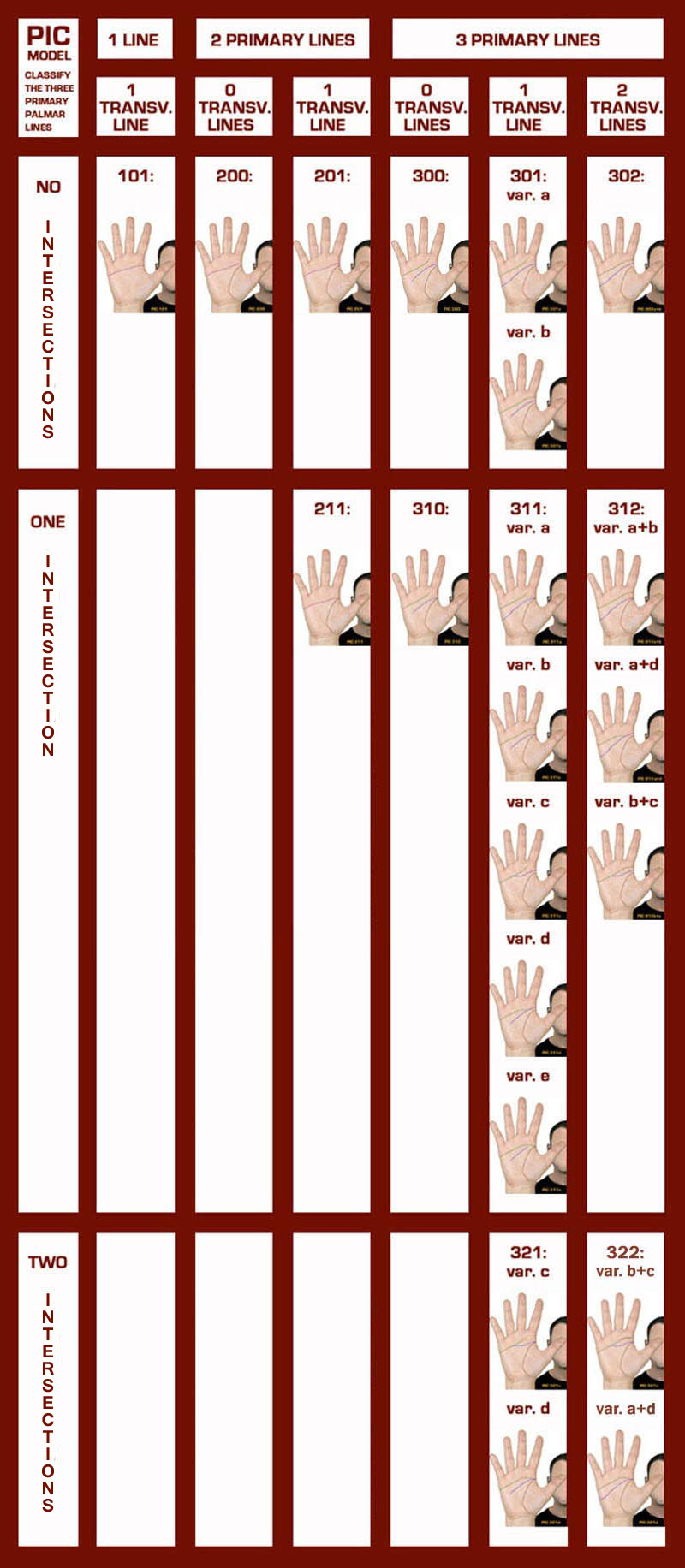
 4 IMPORTANT NOTIFICATIONS FOR USING THE 'PIC MODEL':
4 IMPORTANT NOTIFICATIONS FOR USING THE 'PIC MODEL':
• NOTIFICATION 1 - Only the features of the core of the three major palmar creases (including: the life line, heart line, and head line) should be used to classify a hand; this implicates that minor characteristics and minor lines should be ignored compeletely; and splittings should be analysed very precisely: does it concern a splitting of a minor line from the core (which should be ignored), or a splitting of the core.
One can use the palmistry chart of the most common palmar lines to find and identify the core features.
• NOTIFICATION 2 - A common complication concerns the presence of a "bridge" (and/or connecting lines) between the heart line and the head line.
The quality of a "bridge" and/or a connecting line usually differs from the quality in the core of three 'primary palmar creases'; and if so: then the "bridge" is not a part of the core aspect of the heart line, nor the core aspect of the head line - resulting in that it can be ignored completely.
But if the structure of the "bridge" doesn't really differ from the core of the heart line/head line (this can only be the case when a "bridge" runs smoothly into the heart line and/or head line), then the hand should be classified as one of the 'simian crease'-variants (see notification 5: there are six options available to make a classification in such cases).
• NOTIFICATION 3 - When multiple variants are possibly within one type, for the 3rd aspect of the '3-digit-code' (which relates to the presence of one or two complete 'transversal' lines) the sub-variant is specified by the following codes:
- a = Sydney line (= head line reaches the ulnar side of the palm);
- b = transveral heart line (= heart line reaches the radial side of the palm);
- c = head line connects to the heart line;
- d = heart line connects to the head line;
- e = heart line connects to the life line;
- a+b = combination of a + b;
- a+d = combination of a + d;
- b+c = combination of b + c.
• NOTIFICATION 4 - Each of the 21 'PIC model' types can be classified in a least one of the 8 'PIC model groups': group A to group H
(the 5 complex sub-types that are featured with 2 letters can be classified under 2 groups - see the stars below: * ** *** **** and *****).
- NOTIFICATION 4a: GROUP A
The following 2 'PIC model' types are examples of a group called 'normal variants':
300 and 310.
- NOTIFICATION 4b: GROUP B
The following 4 'PIC model' types are examples of a group called 'classic simian crease variants':
101, 200, 201, and 211.
- NOTIFICATION 4c: GROUP C
The following 5 'PIC model' types are examples of a group called 'simian crease related variants':
311c, 311d, 311e, 321c, 321d.
- NOTIFICATION 4d: GROUP D
The following 4 'PIC model' types are examples of a group called 'complex simian crease variants':
312a+d**, 312b+c***, 322a+d****, and 322b+c*****.
- NOTIFICATION 4e: GROUP E
The following 4 'PIC model' types are examples of a group called 'classic Sydney line variants':
301a, 302, 311a and *312a+b
- NOTIFICATION 4f: GROUP F
The following 2 'PIC model' types are examples of a group called 'complex Sydney line variants' [= PIC type group F]:
312a+d** and 322a+d****.
- NOTIFICATION 4g: GROUP G
The following 'PIC model' types are examples of a group called 'complete transversal heart line variants':
301b, 311b, 312a+b*
- NOTIFICATION 4h: GROUP H
The following 2 'PIC model' types are examples of a group 'complex transversal heart line variants':
312b+c*** and 322b+c*****.
- NOTIFICATION 4i: GROUP I
The following 6 'PIC model' types are examples of a group 'no connections at all variants':
200, 201, 300, 301a, 301b, and 302.
- NOTIFICATION 4j: GROUP J
The following 2 'PIC model' types are examples of a group 'complex no connection between head line and life line variants':
311c, 311d, 311e, 312a+d, and 312b+c.
 ZOOM-IN ON EACH OF THE 21 'PIC MODEL' TYPES:
ZOOM-IN ON EACH OF THE 21 'PIC MODEL' TYPES:
• (1) PIC TYPE '101': the 'isolated' simian line
NOTICE: PIC type '101' is probably the most rare of all 21 PIC types: all three 'primary palmar lines' are fused into 1 single line!
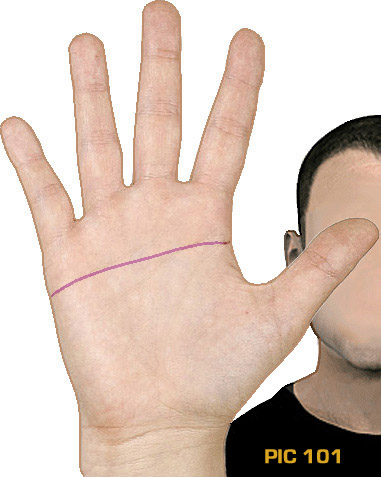
• (2) PIC TYPE '200': the 'short' disconnected simian line
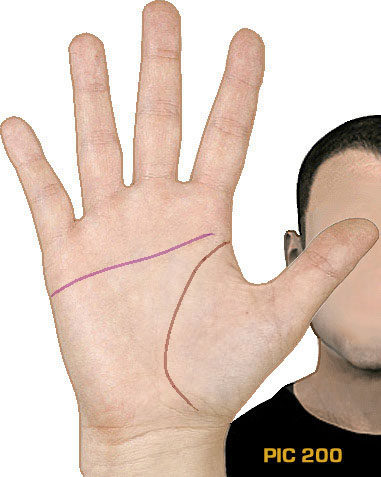
• (3) PIC TYPE '201': the 'long' disconnected simian line
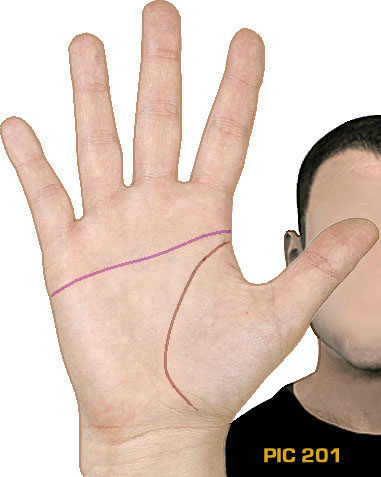
• (4) PIC TYPE '211': the 'classic' simian line
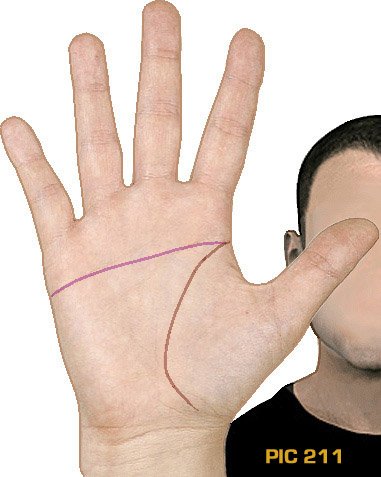
• (5) PIC TYPE '300': the 'dissociated' normal variant
NOTICE: PIC type '300' is the 2nd most common of all 21 PIC types; it can be observed in about 8% of men in both hands, and in about 16% of women both hands can be classified as PIC-type '300'!
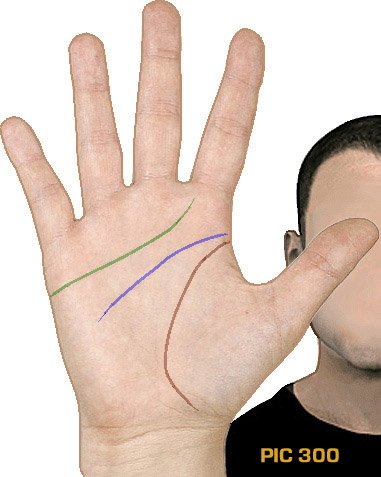
• (6) TWO VARIANTS OF PIC TYPE '301':
>> TYPE '301a' (the 'dissociated' Sydney line) + TYPE '301b' (the 'dissociated' transversal heart line)
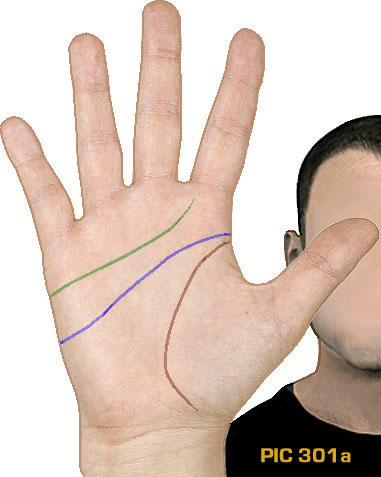
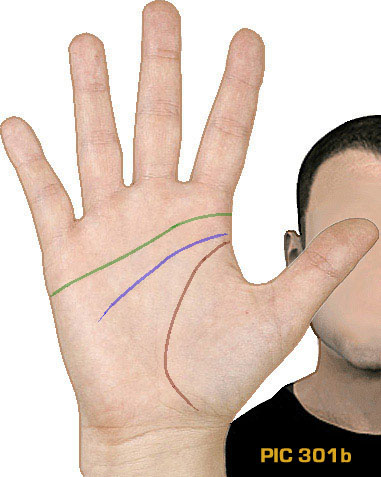
• (7) PIC TYPE '302': the 'disconnected' transversal heart-head line
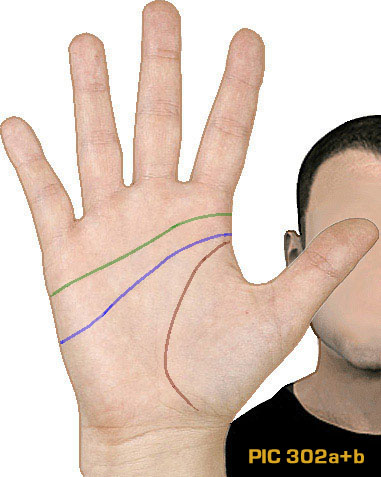
• (8) PIC TYPE '310': the (connected) normal variant
NOTICE: PIC type '310' is by far the most common of all 21 PIC-types; in about 50% of men, and about 40% of women both hands can be classified as PIC-type '310'!
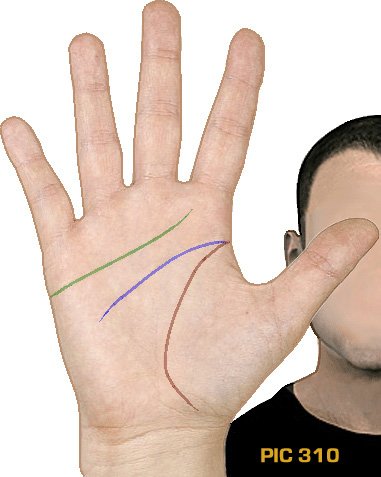
• (9) FIVE VARIANTS OF PIC TYPE '311':
>> TYPE '311a' ('classic' Sydney line) + TYPE '311b' ('classic' transversal heart line) + TYPE '311c' ('proximal' disconnected simian crease) + TYPE '311d' ('distal' disconnected simian crease) + TYPE '311e' ('isolated' head line)
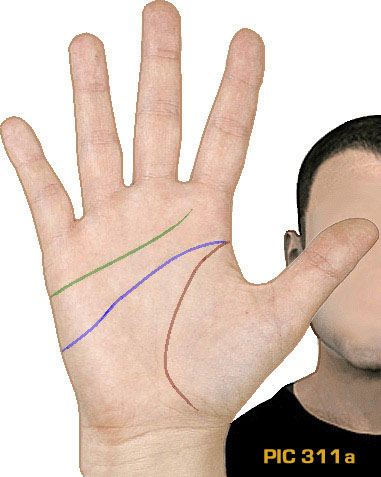
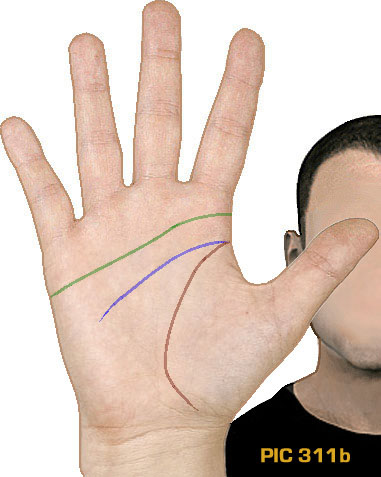
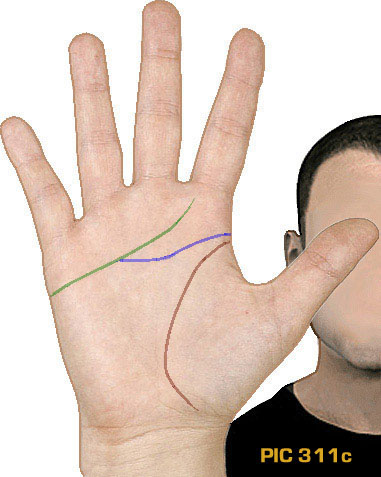
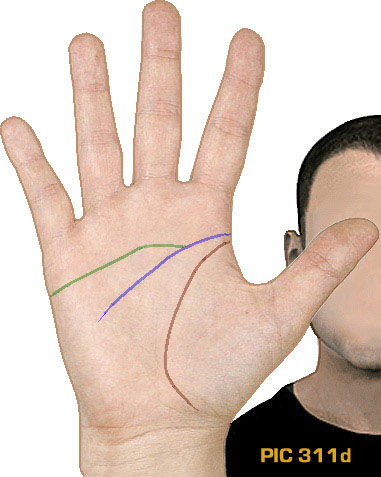
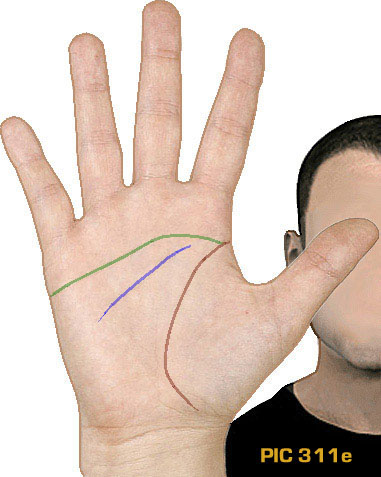
• (10) THREE VARIANTS OF PIC TYPE '312':
>> TYPE '312a+b' (the transversal heart-Sydney line) + TYPE '312a+d' ('distal' disconnected simian-Sydney crease) + TYPE '312b+c' ('proximal' disconnected simian-transversal-heart crease)
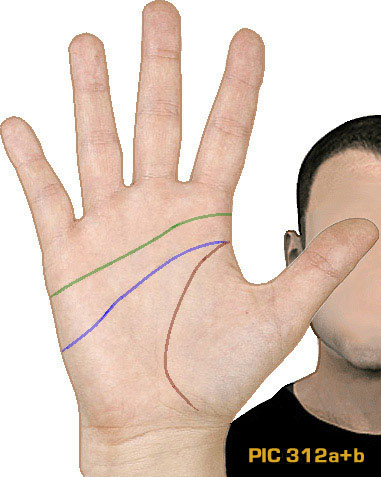
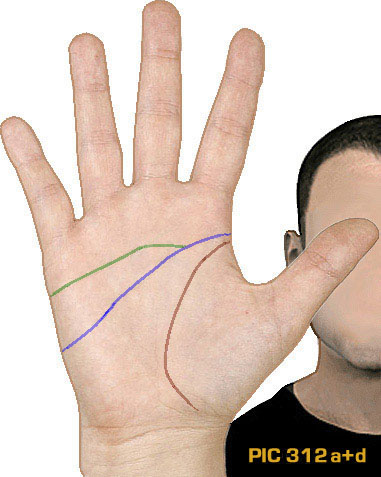
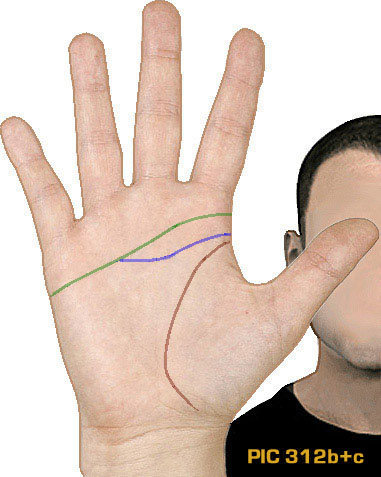
• (11) TWO VARIANTS OF PIC TYPE '321':
>> TYPE '321c' (the 'proximal' simian line) + TYPE '321d' (the 'distal' simian line)
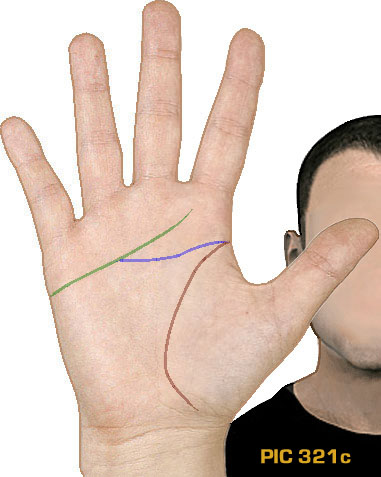
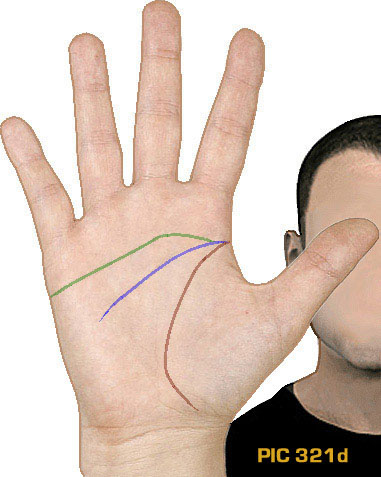
• (12) TWO VARIANTS OF PIC TYPE '322':
>> TYPE '322a+d' (the 'distal' simian-Sydney line) + TYPE '322b+c' (the 'proximal' simian-transversal-heart line)
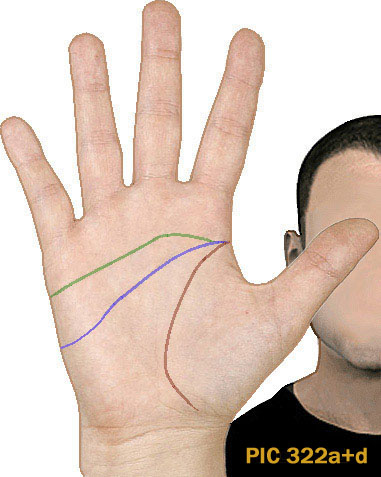
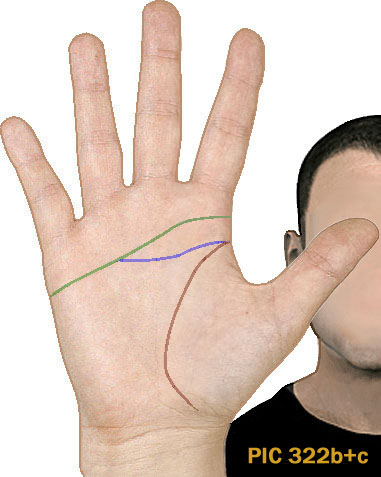
- A 'FAMILY TREE' OF THE PIC TYPES -
Finally, the connections between the individual PIC types can also be illustrated with a 'family tree' of the 3 major hand lines:
Basically the 'family tree' illustrates how various hand line variants are evolved from what has been recognized as the most common variant: 'PIC type 310' - about 50% of people have this variant in both hands!
The colors of the connecting lines illustrate at what stage a PIC type is connected with the most common variant (Green = 1st stage; blue = 2nd stage; purple = 3th stage; and red = 4th stage).
In general, the variants at the highest stage - indicated by the red arrows - belong to the most rare types (these are all seen in about 0.1% of the general population or less).
PICTURE: A 'family tree' of the 3 major hand lines!
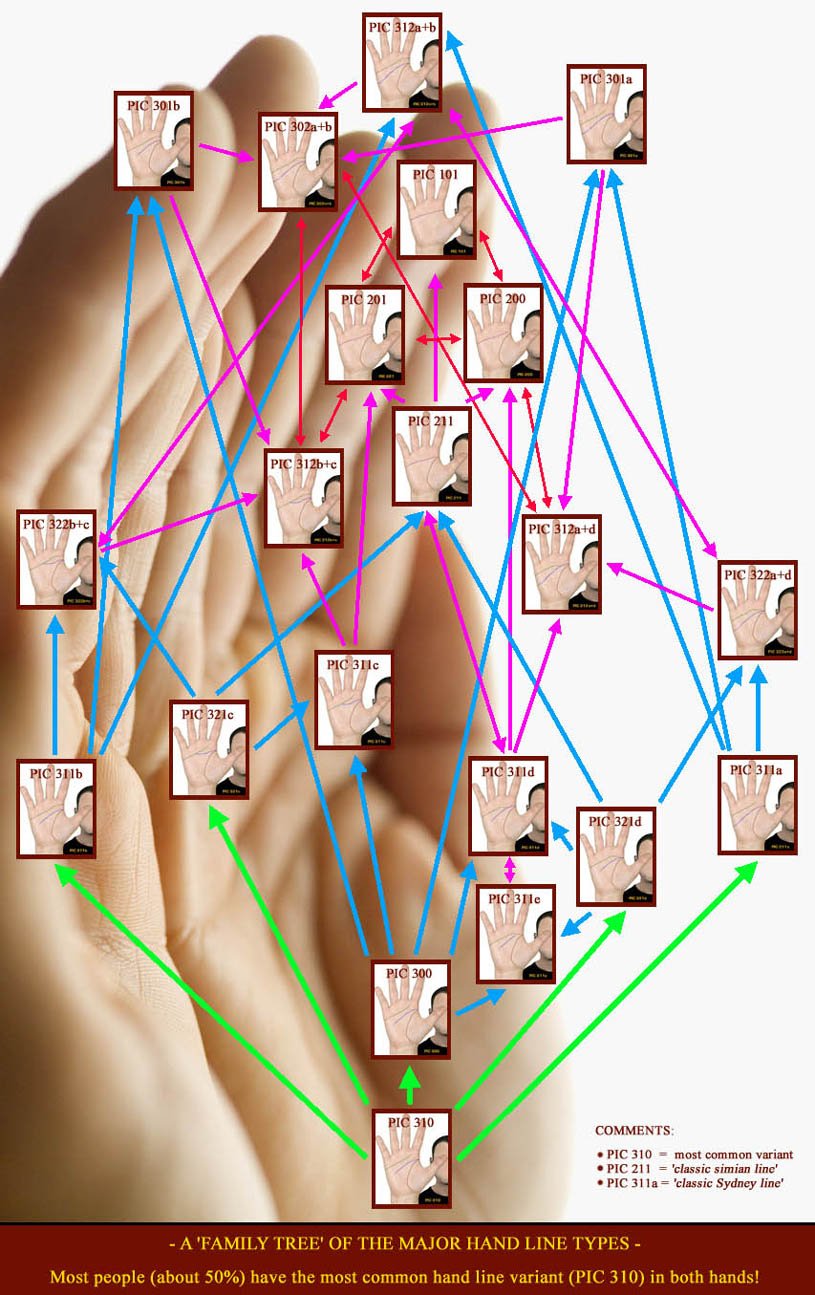
|

|
|























